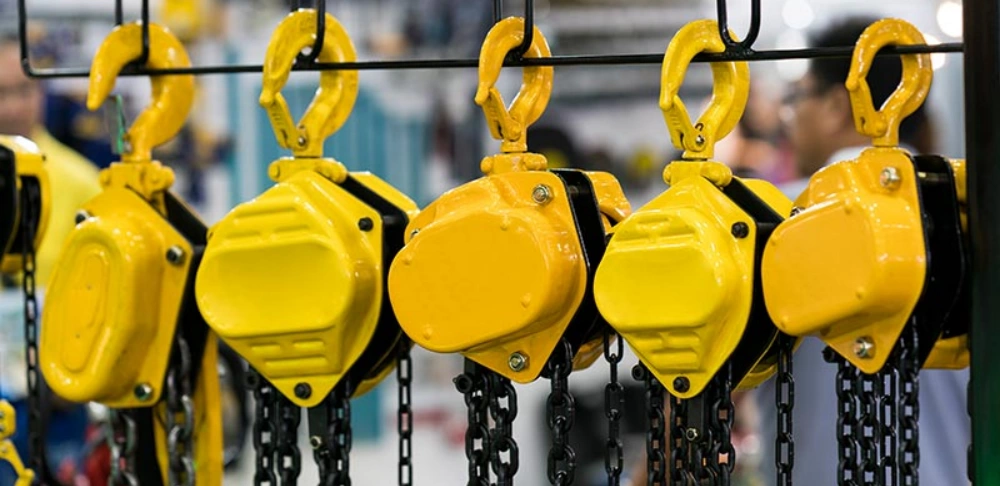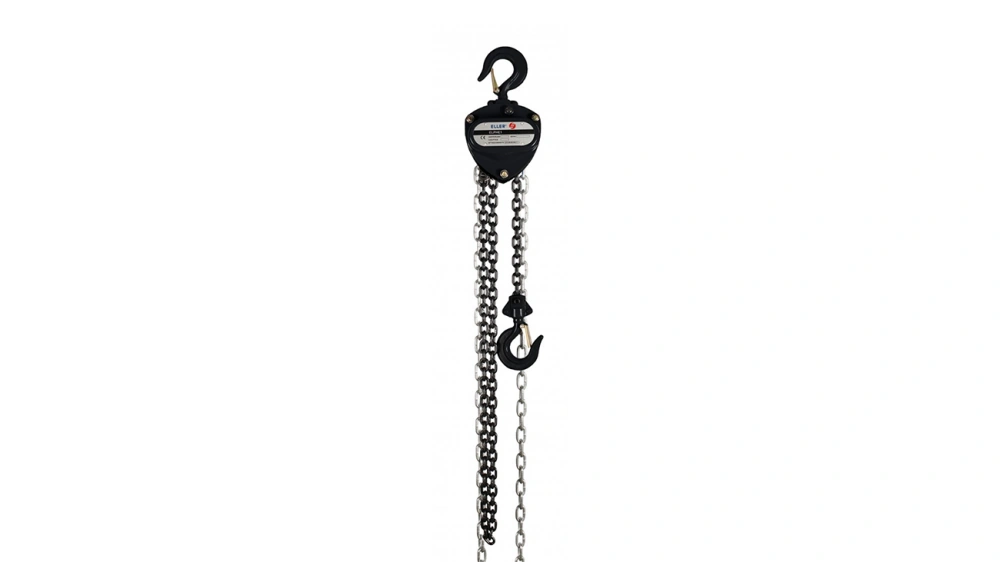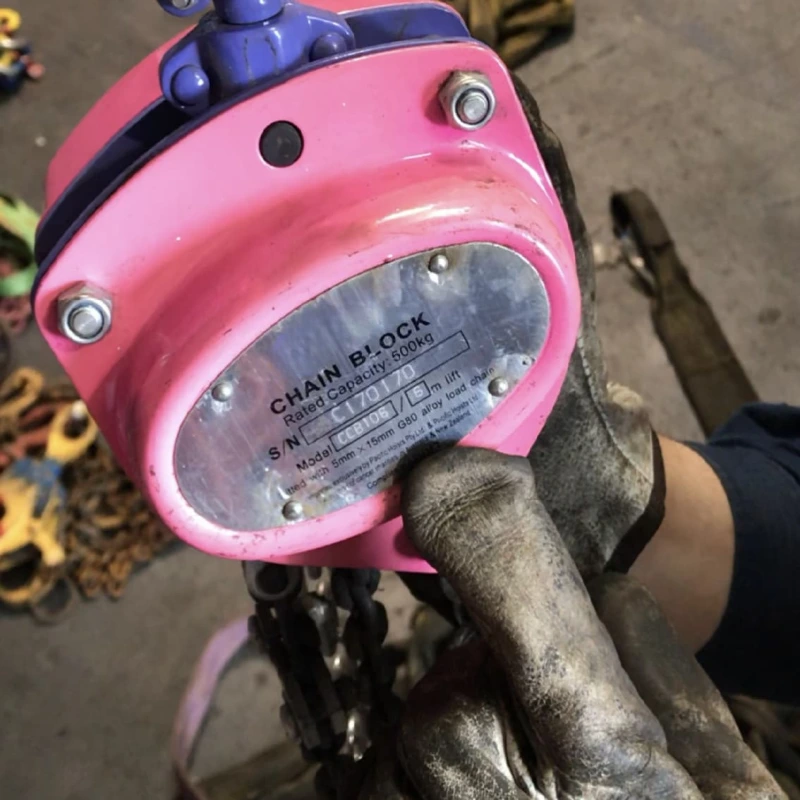You use a chain block to lift and lower heavy loads with precision. This lifting equipment helps you handle materials safely and efficiently. Many industries rely on chain blocks for lifting operations, including:
Construction, where you lift steel beams and scaffolding
Manufacturing, when you move large machines
Shipbuilding, for positioning marine parts
Mining, during equipment maintenance
Warehouses, for loading and unloading materials
Powerful Machinery provides certified chain blocks that support demanding jobs across these fields.
Key Takeaways
Chain blocks are essential tools for lifting heavy loads safely and efficiently in various industries like construction and manufacturing.
Understanding the key components of a chain block, such as the hand chain and brake system, is crucial for safe operation and maintenance.
Choose the right type of chain block—manual, electric, or lever—based on your specific lifting needs and the weight of the load.
Regular inspections and maintenance of chain blocks help prevent accidents and extend the life of the equipment.
Always follow safety guidelines, including checking load limits and using personal protective gear, to ensure safe lifting operations.
What Are Chain Blocks?

Chain Block Definition and Function
You often hear the question: What are chain blocks? A chain block is a type of lifting equipment that helps you raise and lower heavy objects with ease. You use it in lifting operations where safety and control matter most.
Chain blocks use a system of gears and chains to give you a mechanical advantage. This means you can lift loads much heavier than you could by hand.
When you pull the hand chain, the gears inside the chain block rotate. This action multiplies your input force, allowing you to lift large weights with minimal effort. You find chain blocks in many industries, including construction, manufacturing, and warehousing. These tools make lifting operations safer and more efficient.
Powerful Machinery stands out as a trusted manufacturer of chain blocks and lifting solutions. The company produces certified products that meet strict international standards. You can rely on their chain blocks for durability, safety, and performance in demanding environments.
Tip: Chain blocks let you lift heavy loads vertically with less physical effort than other manual devices, such as lever hoists.
Key Components of Chain Blocks
You need to know the main parts of a chain block to understand how it works. Each component plays a key role in safe and effective lifting.
Hand Chain: You operate this chain to start the lifting process. Manufacturers use durable materials to ensure long life.
Load Chain: This chain supports the weight of the load. High-strength steel makes it tough and reliable.
Lifting Hook: You attach this hook to the load. It includes a safety latch to prevent accidental release.
Brake System: This system keeps the load stationary when you stop pulling the chain.
Gears: Precision-engineered gears provide the mechanical advantage needed for heavy lifting.
Housing: The outer shell protects the internal parts and gives the chain block its structure.
Sprocket: This part engages with the load chain, helping you lift smoothly.
You find these components in every chain block from Powerful Machinery. The company uses high-quality materials and advanced engineering to ensure each part meets strict safety standards.
How Does a Chain Block Work?
You might wonder: how do chain blocks work? The answer lies in the gear mechanism inside the device. When you pull the hand chain, pinion gears engage and transfer your force to the reduction gears. These reduction gears multiply your input, so you can lift heavy loads with little effort.
Here is a simple table showing how the main gear components function:
Component | Function |
|---|---|
Internal Gears | Wind the chains around to lift the attached load with minimal force. |
Pinion Gears | Engage with the hand chain to receive the input force. |
Reduction Gears | Multiply the input force, allowing for heavier loads to be lifted easily. |
You use chain blocks for vertical lifting, which means you can raise objects straight up. The mechanical advantage lets you lift loads that may exceed 10 tons, even if you work alone. This makes chain blocks ideal for jobs where you need to move heavy materials safely and efficiently.
Powerful Machinery ensures every chain block meets or exceeds international certifications, such as CE, EN13157, ASME B30.16, and AS1418.2. You get peace of mind knowing your lifting equipment follows strict safety and quality standards.
Note: Always inspect your chain block before use to ensure all components work properly and meet safety requirements.
Chain Block Types and Lifting Capacity
When you choose lifting equipment, you need to understand the main types of chain blocks. Each type serves a different purpose and fits specific lifting operations.
Manual Chain Block

A manual chain block lets you lift heavy loads by pulling a hand chain. You use it for vertical lifting tasks where you need control and precision. Powerful Machinery offers manual chain blocks with advanced safety features and durable construction.
You can find models with capacities ranging from 500 lbs to 40,000 lbs. Here is a quick look at typical lifting capacity options:
Weight Capacity (lbs) |
|---|
500 |
1,000 |
2,000 |
3,000 |
4,000 |
6,000 |
10,000 |
20,000 |
40,000 |

Electric Chain Block
An electric chain block uses a motor to lift and lower loads. You benefit from faster operation and less physical effort. This type is ideal for industrial settings where you need to move heavy items often. Some key advantages include:
Enhanced efficiency and time savings
Improved safety with built-in limit switches and brakes
Higher load capacity for demanding jobs
Durable construction for long-term use
Lower maintenance costs
Electric chain blocks are built with robust materials, so you can use them in tough environments like mining or metalworking.
Lever Chain Block
A lever chain block, also called a lever hoist, works differently from a standard chain block. You operate it by moving a handle or lever, not by pulling a chain. This design lets you lift, pull, or position loads in multiple directions, not just vertically. Here is a comparison:
Feature | Chain Block | Lever Hoist |
|---|---|---|
Operation Mode | Pulling a hand chain | Rotating a handle/lever |
Application | Vertical lifting | Lifting or pulling in any direction |
Load Capacity | Up to 50 tonnes | Up to 10,000 kg |
Lifting Capacity and Chain Grades
You must match the lifting capacity and chain grade to your specific task. Chain blocks use high-strength chains, usually Grade 80 (G80) or Grade 100 (G100). G80 chains have a working load limit (WLL) at about 80% of their minimum breaking strength.
G100 chains offer a WLL closer to 100%, so you can lift heavier loads with the same chain size.
To select the right chain block:
Check that the load weight does not exceed the chain’s WLL.
Choose a chain with a WLL greater than your load.
Add a safety buffer for unexpected shifts.
Always review the manufacturer’s specifications.
Selecting the correct chain grade improves safety and efficiency in your lifting operations. Powerful Machinery provides certified chain blocks with G80 and G100 chains, so you can trust your equipment to handle the job.
What is a Chain Block Used For?
Industries Using Chain Blocks
You see chain blocks in many industries that require safe and reliable lifting equipment. Construction companies use chain blocks to move steel beams and concrete blocks. Manufacturing plants rely on chain blocks to lift machinery and heavy components.
Marine operations depend on chain blocks for securing cargo and lifting containers at docks. Warehouses use chain blocks to stack and reposition pallets or crates. Emergency rescue teams trust chain blocks when lifting debris or stabilizing structures during rescue missions.
These industries choose chain blocks because they handle heavy loads with precision and safety.
Typical Applications and Scenarios
You find many uses of chain blocks in daily work. Chain blocks help you lift heavy loads on construction sites, such as steel beams and concrete blocks. In warehouses, you use chain blocks to move pallets and crates. Marine workers use chain blocks for lifting containers and securing cargo.
Manufacturing teams rely on chain blocks to lift parts during assembly. Rescue workers use chain blocks to lift debris and stabilize damaged buildings. Here is a table showing common applications:
Application Area | Typical Use Case |
|---|---|
Construction Sites | Lifting steel beams, concrete blocks |
Warehouses | Stacking pallets, moving crates |
Marine and Dock Operations | Lifting containers, securing cargo |
Manufacturing | Lifting components, assembly tasks |
Emergency Rescue | Lifting debris, stabilizing structures |
Tip: You improve safety and efficiency when you use chain blocks for lifting operations in these scenarios.
Powerful Machinery Product Advantages
You benefit from the Powerful Machinery chain blocks in every application. The chain block features high-grade steel construction, which gives you strength and durability. You use a secure hook system with a safety latch to prevent accidental release of heavy loads.
Powerful Machinery chain blocks meet strict international standards, so you can trust their reliability in tough environments. You find chain blocks with different lifting capacities, which let you choose the right tool for your job. The compact design makes it easy for you to use chain blocks in confined spaces.
You experience smooth operation and long service life, which reduces downtime and maintenance costs. Powerful Machinery chain blocks give you confidence when handling heavy loads in any industry.
Chain Blocks vs Other Lifting Equipment
Chain Block vs Chain Hoist
You may wonder how a chain block compares to a chain hoist. Both tools help you lift heavy loads, but they work in different ways. A chain block uses manual power. You pull the hand chain to raise or lower the load. A chain hoist often uses electric or pneumatic power.
This means you can lift heavier items with less effort. Electric hoists allow you to control the lifting process with a button or remote. You get smooth and precise movement, which is important in industrial settings.
Here is a table to help you see the main differences:
Feature | Chain Hoist | Chain Block |
|---|---|---|
Power Options | Often electric or pneumatic | Manual only |
Lifting Capabilities | Higher lifting capacity | Lower lifting capacity |
Use | Suited for industrial settings | Better for portable applications |
You will find that chain hoists from Powerful Machinery offer advanced safety features and automation. Electric hoists can operate at exact distances and handle frequent lifting operations. Chain blocks, on the other hand, are simple, portable, and do not need a power source.
Tip: Choose a chain hoist for heavy, repetitive tasks. Use a chain block when you need portability and manual control.
Alternatives to Chain Blocks
You have several alternatives to a chain block when you need lifting equipment. Lever hoists are a popular choice. You use a lever hoist for pulling, tensioning, and lifting. It works in vertical, horizontal, or angled positions. This makes it useful for rigging or machinery installation.
Electric hoists are another option. They use a motor to lift loads quickly and safely.
Here is a quick comparison:
Feature | Chain Block | Lever Hoist |
|---|---|---|
Primary Function | Vertical lifting and lowering | Pulling, tensioning, and lifting |
Orientation | Vertical | Vertical, horizontal, angled |
Common Use Cases | Workshop lifts, assembly lines | Rigging, machinery installation, vehicle recovery |
You should pick the tool that matches your task. Powerful Machinery offers a full range of lifting equipment, including chain blocks, lever hoists, and electric hoists.
When to Use Each Lifting Solution?
You need to consider several factors before choosing the right lifting equipment. First, look at the load. Check its weight, shape, and center of gravity. Some loads need special handling. Next, think about the environment. Humidity, dust, or chemicals can affect the safety and life of your equipment.
Finally, match the tool to your job. Use a chain block for simple, portable lifting. Pick a chain hoist or electric hoist for heavy, frequent, or automated lifting operations.
Understand the load’s characteristics.
Assess the operational environment.
Match the equipment to your specific application.
Powerful Machinery can help you select the best solution for your needs. You get certified products that meet strict safety standards, whether you choose a chain block, chain hoist, or electric hoist.
Safe Use, Inspection, and Maintenance
Safety and Certification
You must follow safety precautions every time you use a chain block. Certified lifting equipment from Powerful Machinery meets strict international standards, giving you confidence during lifting operations. Always check for certification labels before use.
These labels show that your equipment passed safety and quality tests. Never modify your chain block, as this can lead to unsafe conditions and void the warranty.
Safety Hazard | Description |
|---|---|
Chain Detachment | The chain might detach, causing accidents and injuries. |
Chain Separation | The chain can separate from the socket, leading to loss of load control. |
Chain Link Damage | Stretched or straightened links weaken the lifting system. |
Hoist Modification | Modifying the hoist creates unsafe practices and voids the warranty. |
Improper Handling | Not placing the load directly under the block can damage components. |
Angular Lifting | Lifting at an angle increases the risk of equipment failure and injury. |
Tip: Always position the load directly under the chain block and avoid lifting at an angle.
Pre-Use Chain Block Inspection Checklist
Before each use, inspect your chain block carefully. This helps you spot problems early and prevent accidents.
Inspection Item | Description |
|---|---|
Check hooks, suspension, and load | Look for corrosion, cracks, and secure attachment points. |
Check block body | Inspect for corrosion, cracks, and wear. |
Check markings | Make sure safety markings are present and accurate. |
Check dead-end anchorage | Ensure no corrosion or cracks and secure attachment. |
Check the load chain | Look for corrosion, damage, and free movement of links. |
Check the hand chain | Inspect for cracks and smooth movement. |
Check the hoist mechanism | Examine brake, pinions, gearbox, and bearings for wear and alignment. |
Note: If you find any damage or missing parts, do not use the chain block until repairs are made.
Chain Block Maintenance and Lubrication
Regular maintenance keeps your chain blocks working safely. Clean and lubricate all moving parts. Use the right lubricant for your environment:
Petroleum-based lubricants for normal use up to 250°F (120°C).
Open-gear lubricants for exposed gears.
High-temperature lubricants for hot conditions.
NSF H1 lubricants for food contact areas.
Dry chain lubricants for clean, contamination-sensitive spaces.
Set a schedule for inspections:
Maintenance Type | Frequency |
|---|---|
Frequent inspection | Weekly to monthly |
Detailed inspection | Quarterly to semi-annual |
Full teardown and test | Annually or as needed |
Storage and Troubleshooting
Store your chain block in a clean, dry place. Clean the chains before storage and use anti-rust sprays if needed. Keep the equipment off the ground and away from chemicals. Use racks that allow air circulation.
If you notice problems like chain wear, noise, or improper movement, check for misalignment, lack of lubrication, or worn parts. Adjust, lubricate, or replace parts as needed. Tighten loose bolts and correct any installation issues.
Remember: Regular care and inspection help you avoid the most common issues and extend the life of your lifting equipment.
Conclusion
You now understand that a chain block is essential for safe and efficient lifting equipment. You can choose from manual, lever, or electric chain blocks to match your lifting operations. When selecting a certified chain block, always check the load weight, inspect for wear, and confirm certifications.
Always use proper lifting techniques and personal protection gear.
Never exceed the safe working load or leave suspended loads unattended.
Powerful Machinery offers expert resources and technical guides to help you select and maintain your lifting equipment with confidence.
FAQ
What is the difference between a chain block and a chain hoist?
You operate a chain block manually by pulling a hand chain. A chain hoist often uses electric or pneumatic power. Chain hoists lift heavier loads faster. Chain blocks work best for portable, manual lifting tasks.
How do you choose the right chain block size?
You check the weight of your load first. Always select a chain block with a working load limit higher than your load. Add a safety margin. Review the manufacturer’s specifications for guidance.
How often should you inspect your chain block?
You should inspect your chain block before every use. Perform a detailed inspection at least once every three months. Schedule a full teardown and test once a year.
Tip: Regular inspections help you spot problems early and keep your lifting equipment safe.
Can you use a chain block horizontally?
No, you should only use a chain block for vertical lifting. Using it horizontally can damage the equipment and create safety risks. Always follow the manufacturer’s instructions for safe operation.


